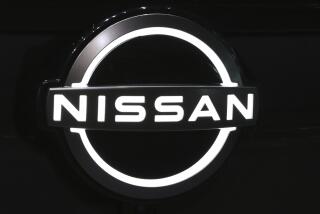Ford to Install New Air Bags to Limit Risk
- Share via
DETROIT — In an effort to reduce the risk of death and injury from air bags, Ford Motor Co. on Wednesday became the first auto maker to make a broad commitment to equipping vehicles with “smart” air bag systems.
Elements of the sophisticated system will be introduced as early as late this summer at no added cost to consumers. The system is designed to make air bags less dangerous to all occupants, but particularly children and small-stature adults, who are most vulnerable to air bag injury.
During this decade, air bags have killed 122 people in the United States, including 68 children. Many of the deaths occurred during minor mishaps in which there was likely to be no injury from the crashes themselves.
The advanced restraint system uses numerous sensors to electronically control seat belt tension and air bag deployment based on crash severity and occupants’ weight, seat position and belt usage.
Ford will install the system in existing models as they are redesigned, probably beginning with the 2000 Taurus mid-size sedan. Within three years, all new Ford cars and trucks should be equipped with the new system.
“We will have the system on the road later this year,” Helen Petrauskas, vice president of Ford safety engineering, said in an interview at the North American International Auto Show in Detroit, where the announcement was made. The initiative marks Ford’s latest effort to gain a competitive advantage by touting safety. In April, Ford became the first U.S. auto maker to commit to installing side-impact air bags on all models within three years.
All auto makers are working on smart air bag systems, and some, including DaimlerChrysler and Porsche of Germany, have already introduced some elements. But Ford says it is the first to make a commitment to an integrated system throughout its product portfolio.
Consumer-safety advocates said the Ford announcement appears to represent a significant advance toward solving the problem of overly powerful air bags. Although the safety devices--now in 79 million vehicles and required in all new vehicles--are estimated to have saved nearly 3,500 lives since 1990, they also caused the gruesome deaths of nearly six dozen youngsters in mostly low-speed mishaps.
Ford’s safety initiative comes as the National Highway Traffic Safety Administration moves this year to adopt new regulations requiring auto makers to install smart air bag systems beginning in three years.
NHTSA Administrator Ricardo Martinez issued a statement Wednesday applauding auto industry efforts to improve air bag safety “through the use of properly tested technology.” He declined to comment on Ford’s system until his staff could evaluate it.
In recent years, federal regulators have taken steps to mitigate the air bag problem. They required auto makers to install warning labels, allowed manufacturers to de-power the devices and permitted the installation of on-off switches. But these were short-term steps taken until standards for smart systems could be developed.
The agency’s proposed rules mandate that advanced air bag systems be phased in between 2002 and 2005. The government will not demand specific designs but will require auto makers to demonstrate that systems meet injury limits in crash tests.
U.S. auto makers, including Ford, initially opposed the proposal for smart air bags, first made by regulators in 1996. The car makers argued that the technology was not yet available and would be costly and difficult to make fail-safe.
But consumer groups argued that much of the technology was already on the shelf and could be added to vehicles for between $25 and $165. They also said new regulations would speed development of affordable systems.
Ford provided only scant details about its system, which employs nearly a dozen advanced components that work together to improve protection of front-seat occupants in frontal crashes. The sensors are integrated into an electronic control unit that makes decisions within milliseconds.
“The technology involved in this system is nothing short of amazing,” said Petrauskas, noting that it is another example of a mechanical system being replaced by silicon-based electronics.
Another element of the system is dual-inflating air bags. They vary the force of deployment through a staged inflation that depends on the driver’s proximity to the steering wheel, the passenger’s weight and the crash’s severity.
The seat belts are equipped with pretensioners that tighten to prevent an occupant from moving during a minor collision. They also have retractors equipped with a metal bar designed to absorb crash energy and loosen the belt slightly in accidents involving more force.
The system is designed to perform differently in each accident situation, Petrauskas said. For instance, if a small woman driving a truck hit another vehicle at 8 mph, her air bag would probably not deploy, especially if she were wearing a seat belt.
But if a 170-pound man driving a sedan at 40 mph ran a red light and hit a tractor-trailer broadside, his air bag would inflate as quickly as possible.






